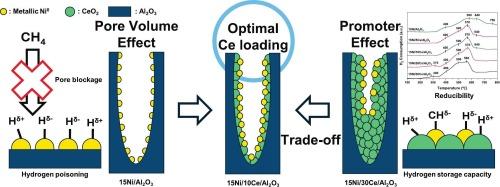Production of CO2-free hydrogen via catalytic methane decomposition over Ce-promoted Ni/Al2O3 catalysts
IF 7.7
2区 工程技术
Q1 CHEMISTRY, APPLIED
引用次数: 0
Abstract
Catalytic methane decomposition (CMD) is a promising reaction for CO2-free hydrogen production, as it generates no CO2 emissions and produces solid carbon byproducts. However, catalyst deactivation due to carbon accumulation necessitates the development of catalysts with high activity, stability, and high capacity for carbon products. In this study, Ce-promoted Ni/Al2O3 catalysts were synthesized with varying Ce loadings to investigate the role of Ce in enhancing catalyst performance. The addition of Ce was found to weaken the interaction between Ni and Al2O3, thereby increasing the surface concentration of metallic Ni0 and improving catalytic activity. Nevertheless, excessive Ce loading resulted in performance deterioration, primarily due to a significant reduction in mesoporous volume. This loss of physical space limited the growth of carbon products and hindered catalyst effectiveness. The results highlight the need to balance the promotional effects of Ce with the preservation of pore structure to optimize catalyst design for CMD.

ce促进的Ni/Al2O3催化剂催化甲烷分解制无co2氢
催化甲烷分解(CMD)是一种很有前途的无二氧化碳制氢反应,因为它不产生二氧化碳排放,只产生固体碳副产品。然而,由于碳积累导致催化剂失活,需要开发具有高活性、稳定性和高碳产物容量的催化剂。在本研究中,合成了不同Ce负载的Ce促进Ni/Al2O3催化剂,以研究Ce在提高催化剂性能方面的作用。Ce的加入减弱了Ni和Al2O3之间的相互作用,从而提高了金属Ni0的表面浓度,提高了催化活性。然而,过量的Ce载荷导致性能下降,主要是由于介孔体积的显著减少。这种物理空间的损失限制了碳产物的生长,阻碍了催化剂的有效性。研究结果表明,需要平衡Ce的促进作用和保持孔隙结构,以优化CMD催化剂的设计。
本文章由计算机程序翻译,如有差异,请以英文原文为准。
求助全文
约1分钟内获得全文
求助全文
来源期刊

Fuel Processing Technology
工程技术-工程:化工
CiteScore
13.20
自引率
9.30%
发文量
398
审稿时长
26 days
期刊介绍:
Fuel Processing Technology (FPT) deals with the scientific and technological aspects of converting fossil and renewable resources to clean fuels, value-added chemicals, fuel-related advanced carbon materials and by-products. In addition to the traditional non-nuclear fossil fuels, biomass and wastes, papers on the integration of renewables such as solar and wind energy and energy storage into the fuel processing processes, as well as papers on the production and conversion of non-carbon-containing fuels such as hydrogen and ammonia, are also welcome. While chemical conversion is emphasized, papers on advanced physical conversion processes are also considered for publication in FPT. Papers on the fundamental aspects of fuel structure and properties will also be considered.
 求助内容:
求助内容: 应助结果提醒方式:
应助结果提醒方式:


